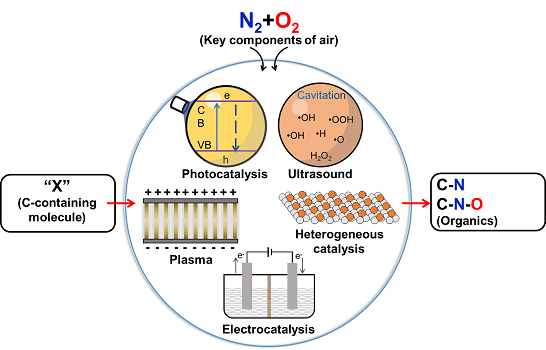Nitrogen (N2) and oxygen (O2) are the key components of air (contributing to 78.1 vol.% and 20.9 vol.%, respectively). Their elements are the vital constituents of living organisms that occur in proteins, DNA, RNA, and amino acids. Direct conversion of abundant N2 and O2 into NO2 and C-N-O organics, rather than via the intermediate NH3 from the Haber-Bosch process, is a fascinating process.
However, the extremely strong N≡N triple bond (945 kJ mol-1) and the stable nonpolar electron configuration of dinitrogen render its conversion an extensively energy demanding process. The further selective synthesis of high-value C-N-O organics directly from N2, O2, and C-containing molecules is attractive yet greatly challenging from both fundamental research and engineering perspectives.
Recently, a research group led by Prof. DENG Dehui from the Dalian Institute of Chemical Physics (DICP) of the Chinese Academy of Sciences (CAS) summarized the main conversion pathways of N2 and O2 with the related technical methods of this area.

Schematic illustration of strategies and perspectives for direct conversion of key air components (Image by LI Di)
The researchers discussed the status and challenges in the direct conversion of N2, O2, and C-containing molecules (particularly N2 and O2) via traditional and novel techniques, including thermochemical, plasma, electrochemical, ultrasonic, and photochemical conversion. Furthermore, the researchers proposed some future perspectives and strategies: coupling multiple energy input and reaction processes, introducing other molecules to reduce the reaction energy barrier, and developing new catalysts.
The review article was published in National Science Review and was recently online on Jan. 28, 2023. The work was supported by National Natural Science Foundation of China Center of ‘Transformation Chemistry of Key Components of Air’. (Text by LI Di)
Link: http://www.dicp.ac.cn/xwdt/kyjz/202302/t20230210_6674360.html